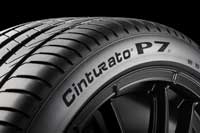
Italian tyre manufacturer Pirelli & C. Spa. (Pirelli) has launched the new Cinturato P7 – a high-performance summer tyre for premium cars, which features a new tread compound equipped with a type of ‘mechanical intelligence’ that can change according to ambient temperatures to ensure optimum performance of the vehicle. The new Cinturato P7 also delivers increased safety, efficiency, and sustainability, and is currently being stocked in all European and Asian markets.
For the latest generation of Pirelli Cinturato P7 tyres, Pirelli’s engineers have come up with a product that features a new technological standard to satisfy drivers and car makers all over the world: the tread pattern specifically created for the new Cinturato P7 is enriched with specific silicon resins that help to increase grip and enhance the function of the tyre’s polymers. The synthetic elastic materials have been chemically modified to improve the interaction with silicon and can change according to the tyre’s working temperature. This means that the new compound benefits from a sort of ‘mechanical intelligence’ thanks to better distribution of the silicon particles and more effective interaction between them – the tyre’s characteristics can change, according to driving and temperature conditions, allowing the driver an extremely wide, optimal working range.
The tread pattern, design and rigidity distribution of the tyre’s shoulder blocks also allows the new Cinturato P7 to have the biggest possible contact patch through tough corners thus providing a safe and precise driving experience. In safety tests carried out by Pirelli, the new Cinturato P7 takes just four fewer metres to come to a stop from 100kph. Having increased the mechanical resistance of the tread pattern compound, not only is less material needed, but the overall weight of the tyre is reduced. Less material means less weight, decreased rolling resistance, and a more mindful use of resources. All this leads to lower fuel consumption (by 4% on the WLTP cycle), saves money and reduces the impact on the environment.
In addition, besides improved performance in dry handling and low rolling resistance, Pirelli’s new tyre has greatly improved wet handling, aquaplaning and braking (the tyres can be optimally tuned to work together with existing driver aids). The innovations introduced by Pirelli’s engineers also improve acoustic and ride comfort, with the new tyre better able to absorb bumps in the road. Overall tyre life is increased by 6% as well, meaning that tyres have to be changed less frequently, while rolling resistance, and in turn CO? emissions, also goes down by an average of one class (minus 12%).
In all, the new Cinturato P7 is able to overcome the typical compromises associated with tyres; and has been adapted for all the different new car models that the tyres are homologated for and to answer the specific requirements of motorists. A survey commissioned by Pirelli recently highlighted the tendency for increased car use in future – especially while social distancing measures are in place. In China, 68% of respondents said they would use their cars more, in Italy the figure was 31%, and in Germany 20%. More than 50% of people surveyed also said that they wanted to change tyres before the end of the year to ensure optimal safety for their cars. The criteria governing their choice showed increased attention to tyre reliability and quality: the percentage of respondents prioritising safety characteristics increased to 59% in Germany, 78% in Italy and 86% in China.
